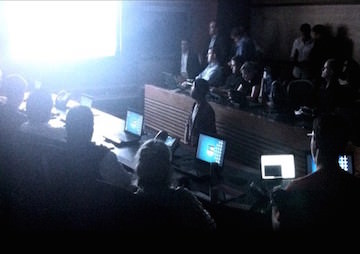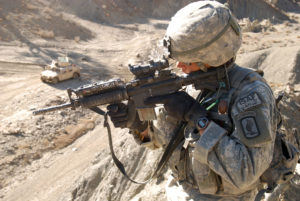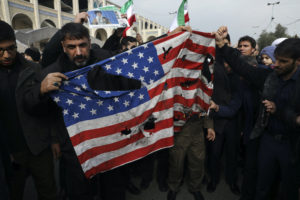Creating an Un-Intelligence Machine
Reports that U.S. Central Command employs some 1,500 analysts indicate that the military has been ramping up its own labyrinthine set of intelligence structures that are drowning in "information." Paul Papadimitrou / CC BY 2.0
Paul Papadimitrou / CC BY 2.0
By Tom Engelhardt, TomDispatchThis piece first appeared at TomDispatch.
1,500.
That figure stunned me. I found it in the 12th paragraph of a front-page New York Times story about “senior commanders” at U.S. Central Command (CENTCOM) playing fast and loose with intelligence reports to give their air war against ISIS an unjustified sheen of success: “CENTCOM’s mammoth intelligence operation, with some 1,500 civilian, military, and contract analysts, is housed at MacDill Air Force Base in Tampa, in a bay front building that has the look of a sterile government facility posing as a Spanish hacienda.”
Think about that. CENTCOM, one of six U.S. military commands that divide the planet up like a pie, has at least 1,500 intelligence analysts (military, civilian, and private contractors) all to itself. Let me repeat that: 1,500 of them. CENTCOM is essentially the country’s war command, responsible for most of the Greater Middle East, that expanse of now-chaotic territory filled with strife-torn and failing states that runs from Pakistan’s border to Egypt. That’s no small task and about it there is much to be known. Still, that figure should act like a flash of lightning, illuminating for a second an otherwise dark and stormy landscape.
And mind you, that’s just the analysts, not the full CENTCOM intelligence roster for which we have no figure at all. In other words, even if that 1,500 represents a full count of the command’s intelligence analysts, not just the ones at its Tampa headquarters but in the field at places like its enormous operation at al-Udeid Air Base in Qatar, CENTCOM still has almost half as many of them as military personnel on the ground in Iraq (3,500 at latest count). Now, try to imagine what those 1,500 analysts are doing, even for a command deep in a “quagmire” in Syria and Iraq, as President Obama recently dubbed it (though he was admittedly speaking about the Russians), as well as what looks like a failing war, 14 years later, in Afghanistan, and another in Yemen led by the Saudis but backed by Washington. Even given all of that, what in the world could they possibly be “analyzing”? Who at CENTCOM, in the Defense Intelligence Agency, or elsewhere has the time to attend to the reports and data flows that must be generated by 1,500 analysts?
Of course, in the gargantuan beast that is the American military and intelligence universe, streams of raw intelligence beyond compare are undoubtedly flooding into CENTCOM’s headquarters, possibly overwhelming even 1,500 analysts. There’s “human intelligence,” or HUMINT, from sources and agents on the ground; there’s imagery and satellite intelligence, or GEOINT, by the bushelful. Given the size and scope of American global surveillance activities, there must be untold tons of signals intelligence, or SIGINT; and with all those drones flying over battlefields and prospective battlefields across the Greater Middle East, there’s undoubtedly a river of full motion video, or FMV, flowing into CENTCOM headquarters and various command posts; and don’t forget the information being shared with the command by allied intelligence services, including those of the “five eyes“ nations, and various Middle Eastern countries; and of course, some of the command’s analysts must be handling humdrum, everyday open-source material, or OSINT, as well — local radio and TV broadcasts, the press, the Internet, scholarly journals, and god knows what else.
And while you’re thinking about all this, keep in mind that those 1,500 analysts feed into, and assumedly draw on, an intelligence system of a size surely unmatched even by the totalitarian regimes of the twentieth century. Think of it: the U.S. Intelligence Community has — count ‘em — 17 agencies and outfits, eating close to $70 billion annually, more than $500 billion between 2001 and 2013. And if that doesn’t stagger you, think about the 500,000 private contractors hooked into the system in one way or another, the 1.4 million people (34% of them private contractors) with access to “top secret” information, and the 5.1 million — larger than Norway’s population — with access to “confidential and secret” information.
Remember as well that, in these years, a global surveillance state of Orwellian proportions has been ramped up. It gathers billions of emails and cell phone calls from the backlands of the planet; has kept tabs on at least 35 leaders of other countries and the secretary general of the U.N. by hacking email accounts, tapping cell phones, and so on; keeps a careful eye and ear on its own citizens, including video gamers; and even, it seems, spies on Congress. (After all, whom can you trust?)
In other words, if that 1,500 figure bowls you over, keep in mind that it just stands in for a far larger system that puts to shame, in size and yottabytes of information collected, the wildest dreams of past science fiction writers. In these years, a mammoth, even labyrinthine, bureaucratic “intelligence” structure has been constructed that is drowning in “information” — and on its own, it seems, the military has been ramping up a smaller but similarly scaled set of intelligence structures.
Surprised, Caught Off Guard, and Left Scrambling
The question remains: If data almost beyond imagining flows into CENTCOM, what are those 1,500 analysts actually doing? How are they passing their time? What exactly do they produce and does it really qualify as “intelligence,” no less prove useful? Of course, we out here have limited access to the intelligence produced by CENTCOM, unless stories like the one about top commanders fudging assessments on the air war against the Islamic State break into the media. So you might assume that there’s no way of measuring the effectiveness of the command’s intelligence operations. But you would be wrong. It is, in fact, possible to produce a rough gauge of its effectiveness. Let’s call it the TomDispatch Surprise Measurement System, or TSMS. Think of it as a practical, news-based guide to the questions: What did they know and when did they know it?
Let me offer a few examples chosen almost at random from recent events in CENTCOM’s domain. Take the seizure at the end of September by a few hundred Taliban fighters of the northern provincial Afghan capital of Kunduz, the first city the Taliban has controlled, however briefly, since it was ejected from that same town in 2002. In the process, the Taliban fighters reportedly scattered up to 7,000 members of the Afghan security forces that the U.S. has been training, funding, and arming for years.
For anyone following news reports closely, the Taliban had for months been tightening its control over rural areas around Kunduz and testing the city’s defenses. Nonetheless, this May, based assumedly on the best intelligence analyses available from CENTCOM, the top U.S. commander in the country, Army General John Campbell, offered this predictive comment: “If you take a look very closely at some of the things in Kunduz and up in [neighboring] Badakhshan [Province], [the Taliban] will attack some very small checkpoints… They will go out and hit a little bit and then they kind of go to ground… so they’re not gaining territory for the most part.’”
As late as August 13th, at a press briefing, an ABC News reporter asked Brigadier General Wilson Shoffner, the U.S. deputy chief of staff for communications in Afghanistan: “There has been a significant increase in Taliban activity in northern Afghanistan, particularly around Kunduz. What is behind that? Are the Afghan troops in that part of Afghanistan at risk of falling to the Taliban?”
Shoffner responded, in part, this way: “So, again, I think there’s been a lot of generalization when it comes to reports on the north. Kunduz is — is not now, and has not been in danger of being overrun by the Taliban, and so — with that, it’s kind of a general perspective in the north, that’s sort of how we see it.”
That General Cambell at least remained of a similar mindset even as Kunduz fell is obvious enough since, as New York Times reporter Matthew Rosenberg reported, he was out of the country at the time. As Goldstein put it:
“Mostly, though, American and Afghan officials appeared to be genuinely surprised at the speedy fall of Kunduz, which took place when Gen. John F. Campbell, the commander of coalition forces, was in Germany for a defense conference… Though the Taliban have been making gains in the hinterlands around Kunduz for months, American military planners have for years insisted that Afghan forces were capable of holding onto the country’s major cities.
“‘This wasn’t supposed to happen,’ said a senior American military officer who served in Afghanistan, speaking on the condition of anonymity. ‘The Afghans are fighting, so it’s not like we’re looking at them giving up or collapsing right now. They’re just not fighting very well.’”
It’s generally agreed that the American high command was “caught off guard” by the capture of Kunduz and particularly shocked by the Afghan military’s inability to fight effectively. And who would have predicted such a thing of an American-trained army in the region, given that the American-backed, -trained, and -equipped Iraqi Army on the other side of the Greater Middle East had a similar experience in June 2014 in Mosul and other cities of northern Iraq when relatively small numbers of Islamic State militants routed its troops?
At that time, U.S. military leaders and top administration officials right up to President Obama were, as the Wall Street Journal reported, “caught off guard by the swift collapse of Iraqi security forces” and the successes of the Islamic State in northern Iraq. Peter Baker and Eric Schmitt of the Times wrote in retrospect, “Intelligence agencies were caught off guard by the speed of the extremists’… advance across northern Iraq.” And don’t forget that, despite that CENTCOM intelligence machine, something similar happened in May 2015 when, as Washington Post columnist David Ignatius put it, U.S. officials and American intelligence were “blindsided again” by a very similar collapse of Iraqi forces in the city of Ramadi in al-Anbar Province.
Or let’s take another example where those 1,500 analysts must have been hard at work: the failed $500 million Pentagon program to train “moderate” Syrians into a force that could fight the Islamic State. In the Pentagon version of the elephant that gave birth to a mouse, that vast effort of vetting, training, and arming finally produced Division 30, a single 54-man unit of armed moderates, who were inserted into Syria near the forces of the al-Qaeda-aligned al-Nusra Front. That group promptly kidnapped two of its leaders and then attacked the unit. The result was a disaster as the U.S.-trained fighters fled or were killed. Soon thereafter, the American general overseeing the war against the Islamic State testified before Congress that only “four or five” armed combatants from the U.S. force remained in the field.
Here again is how the New York Times reported the response to this incident:
“In Washington, several current and former senior administration officials acknowledged that the attack and the abductions by the Nusra Front took American officials by surprise and amounted to a significant intelligence failure. While American military trainers had gone to great lengths to protect the initial group of trainees from attacks by Islamic State or Syrian Army forces, they did not anticipate an assault from the Nusra Front. In fact, officials said on Friday, they expected the Nusra Front to welcome Division 30 as an ally in its fight against the Islamic State.
“‘This wasn’t supposed to happen like this,’ said one former senior American official, who was working closely on Syria issues until recently, and who spoke on the condition of anonymity to discuss confidential intelligence assessments.”
Now, if accurate, this is wild stuff. After all, how anyone, commander or intelligence analyst, could imagine that the al-Nusra Front, classified as an enemy force in Washington and some of whose militants had been targeted by U.S. air power, would have welcomed U.S.-backed troops with open arms is the mystery of all mysteries. One small footnote to this: McClatchy News later reported that the al-Nusra Front had been poised to attack the unit because it had tipped off in advance by Turkish intelligence, something CENTCOM’s intelligence operatives evidently knew nothing about.
In the wake of that little disaster and again, assumedly, with CENTCOM’s full stock of intelligence and analysis on hand, the military inserted the next unit of 74 trained moderates into Syria and was shocked (shocked!) when its members, chastened perhaps by the fate of Division 30, promptly handed over at least a quarter of their U.S.-supplied equipment, including trucks, ammunition, and rifles, to the al-Nusra Front in return for “safe passage.” Al-Nusra militants soon were posting photos of the weapons online and tweeting proudly about them. CENTCOM officials initially denied that any of this had happened (and were clearly in the dark about it) before reversing course and reluctantly admitting that it was so. (“‘If accurate, the report of NSF [New Syrian Forces] members providing equipment to al-Nusra Front is very concerning and a violation of Syria train-and-equip program guidelines,’ U.S. Central Command spokesman Colonel Patrick Ryder said.”)
To turn to even more recent events in CENTCOM’s bailiwick, American officials were reportedly similarly stunned as September ended when Russia reached a surprise agreement with U.S. ally Iraq on an anti-ISIS intelligence-sharing arrangement that would also include Syria and Iran. Washington was once again “caught off guard” and, in the words of Michael Gordon of the Times, “left… scrambling,” even though its officials had known “that a group of Russian military officers were in Baghdad.”
Similarly, the Russian build-up of weaponry, planes, and personnel in Syria initially “surprised” and — yes — caught the Obama administration “off guard.” Again, despite those 1,500 CENTCOM analysts and the rest of the vast U.S. intelligence community, American officials, according to every news report available, were “caught flat-footed” and, of course, “by surprise” (again, right up to the president) when the Russians began their full-scale bombing campaign in Syria against various al-Qaeda-allied outfits and CIA-backed opponents of Syrian President Bashar al-Assad. They were even caught off guard and taken aback by the way the Russians delivered the news that their bombing campaign was about to start: a three-star Russian general arrived at the U.S. Embassy in Baghdad to offer an hour’s notice. (Congressional lawmakers are now considering “the extent to which the spy community overlooked or misjudged critical warning signs” about the Russian intervention in Syria.)
The Fog Machine of American Intelligence
You get the point. Whatever the efforts of that expansive corps of intelligence analysts (and the vast intelligence edifice behind it), when anything happens in the Greater Middle East, you can essentially assume that the official American reaction, military and political, will be “surprise” and that policymakers will be left “scrambling” in a quagmire of ignorance to rescue American policy from the unexpected. In other words, somehow, with what passes for the best, or at least most extensive and expensive intelligence operation on the planet, with all those satellites and drones and surveillance sweeps and sources, with crowds of analysts, hordes of private contractors, and tens of billions of dollars, with, in short, “intelligence” galore, American officials in the area of their wars are evidently going to continue to find themselves eternally caught “off guard.”
The phrase “the fog of war” stands in for the inability of commanders to truly grasp what’s happening in the chaos that is any battlefield. Perhaps it’s time to introduce a companion phrase: the fog of intelligence. It hardly matters whether those 1,500 CENTCOM analysts (and all those at other commands or at the 17 major intelligence outfits) produce superlative “intelligence” that then descends into the fog of leadership, or whether any bureaucratic conglomeration of “analysts,” drowning in secret information and the protocols that go with it, is going to add up to a giant fog machine.
It’s difficult enough, of course, to peer into the future, to imagine what’s coming, especially in distant, alien lands. Cobble that basic problem together with an overwhelming data stream and groupthink, then fit it all inside the constrained mindsets of Washington and the Pentagon, and you have a formula for producing the fog of intelligence and so for seldom being “on guard” when it comes to much of anything.
My own suspicion: you could get rid of most of the 17 agencies and outfits in the U.S. Intelligence Community and dump just about all the secret and classified information that is the heart and soul of the national security state. Then you could let a small group of independently minded analysts and critics loose on open-source material, and you would be far more likely to get intelligent, actionable, inventive analyses of our global situation, our wars, and our beleaguered path into the future.
The evidence, after all, is largely in. In these years, for what now must be approaching three-quarters of a trillion dollars, the national security state and the military seem to have created an un-intelligence system. Welcome to the fog of everything.
Tom Engelhardt is a co-founder of the American Empire Project and the author of The United States of Fear as well as a history of the Cold War, The End of Victory Culture. He is a fellow of the Nation Institute and runs TomDispatch.com. His latest book is Shadow Government: Surveillance, Secret Wars, and a Global Security State in a Single-Superpower World.
[Note: Nick Turse was my co-conspirator on this piece and I thank him for all his help.]
Follow TomDispatch on Twitter and join us on Facebook. Check out the newest Dispatch Book, Nick Turse’s Tomorrow’s Battlefield: U.S. Proxy Wars and Secret Ops in Africa, and Tom Engelhardt’s latest book, Shadow Government: Surveillance, Secret Wars, and a Global Security State in a Single-Superpower World.
Copyright 2015 Tom Engelhardt
Your support matters…Independent journalism is under threat and overshadowed by heavily funded mainstream media.
You can help level the playing field. Become a member.
Your tax-deductible contribution keeps us digging beneath the headlines to give you thought-provoking, investigative reporting and analysis that unearths what's really happening- without compromise.
Give today to support our courageous, independent journalists.






You need to be a supporter to comment.
There are currently no responses to this article.
Be the first to respond.